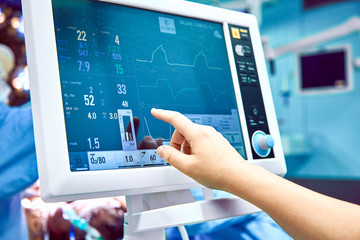Some tests for patients in intensive care units depend on direct observation and physical examination, and are done intermittently, with a frequency that depends on the pathology presented by the patient, while other parameters must be continuously monitored through medical equipment such as the patient monitor, this device allows the detection, processing and continuous deployment of complex physiological parameters of the patient.
A patient monitor, depending on its configuration, can measure and display more than 20 different types of parameters, from sensors and devices that are placed on the patient, and has an integrated alarm system that alerts medical and nursing staff when there is an adverse situation or outside the desired limits. This allows each intensive care unit to follow established alert evaluation protocols.
What is the function of a patient monitor for intensive care?
The main function of patient monitoring for intensive care is to collect, display and store all vital signs of the patient. The parameters are shown separately in the Vital Signal Monitor. If any of them are below or above normal for the patient’s age, or any other adverse activity occurs, an alarm is triggered to alert doctors. These alarms are visual and sound, but can be easily silenced if you are trying to solve the problem that has generated them.
They are particularly useful medical devices in patients undergoing anesthesia, medicines or any other treatment that determines the need for blood, variation in medication or volume replacement, such as a plasma expander.
How is cardiac monitoring performed on a patient monitor?
Commonly in intensive care patients, cardiac activity is monitored using a three-electrode system, and signals from these are sent to the central monitor station via a small transmitter in the patient.
And because each monitor has an automatic system that allows to alert in the event of abnormalities of the heart rate and rhythm, and also allow to store such information for future review.
Benefits of Intensive Care Patient Monitors
- Some computers give the specialist the ability to connect remotely through web applications. This makes it easier to monitor parameters, identify warning signs, and improve decision-making in real time, even if the doctor is not in the health institution.
- Other equipment has the ability to transmit information to the monitoring network via wireless transmission, allowing quick access to the treating specialists, via the central station.
- Some devices are equipped with the ability to analyze ST segments and heart arrhythmias, in addition to having 12-lead ECG with intelligent interpretation.
- They allow the possibility of automatically integrating patient data into the electronic medical record, as well as information from other equipment such as anesthesia machines, infusion pumps, among others.
What do we offer you in Kalstein?
Kalstein is a company MANUFACTURER of medical and laboratory equipment of the highest quality and that have the most advanced technology at the best prices in the market, so we guarantee you a safe and effective purchase, knowing that you have the service of a solid company and committed to health. This time we present our patient monitor YR 02175. It is a semi-modular monitor of medium and high complexity, specially designed to be used in ICU, Pavilion and Emergency in Adult, Pediatric or Neonatal patients. Among its main characteristics we find:
- The model features a large 12.1-inch TFT color LCD with anti-glare system and Touch Screen function, plus a backup battery of up to 3.5 hrs.
- It can also be connected to a monitoring station and incorporates protocol to connect to HIS, CIS, LIS and PACS systems, and with port for 2G SD memory card.
- Basic parameters included: ECG, ST, Arrhythmia, Respiration, 2 Temperature, SpO2, Noninvasive Pressure, PPI.
- Additional parameters and options: SpO2 Masimo (Rainbow), SpO2 Nellcor, 2 to 8 Invasive Pressures, Analysis of Anesthetic Agents, CO2 (MainStream, SideStream, MicroStream), FiO2, Invasive and Non-Invasive Cardiac Expenditure, Printer Module.
For more information we invite you to take a look HERE

